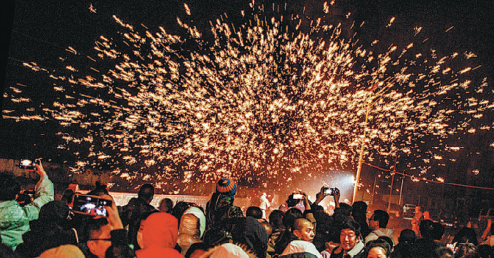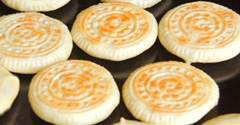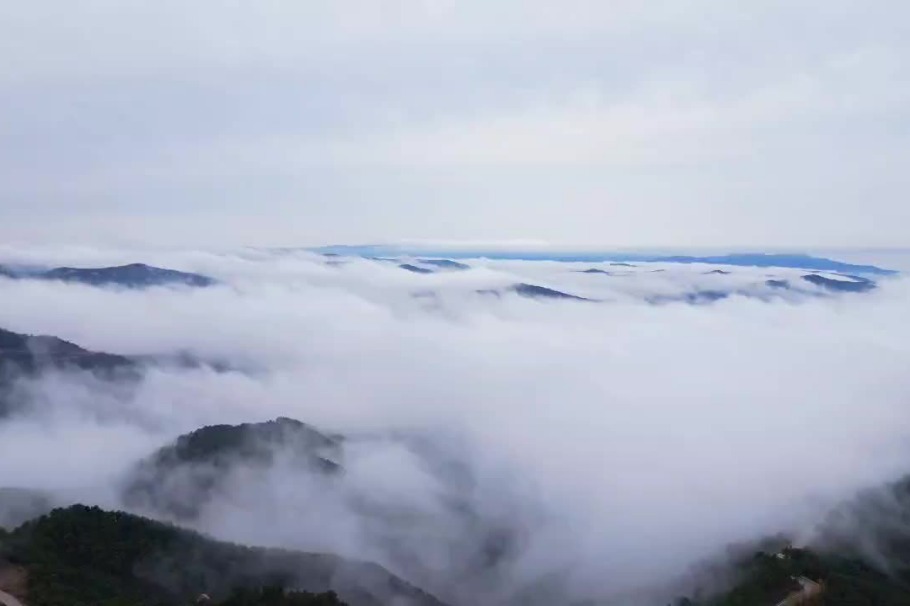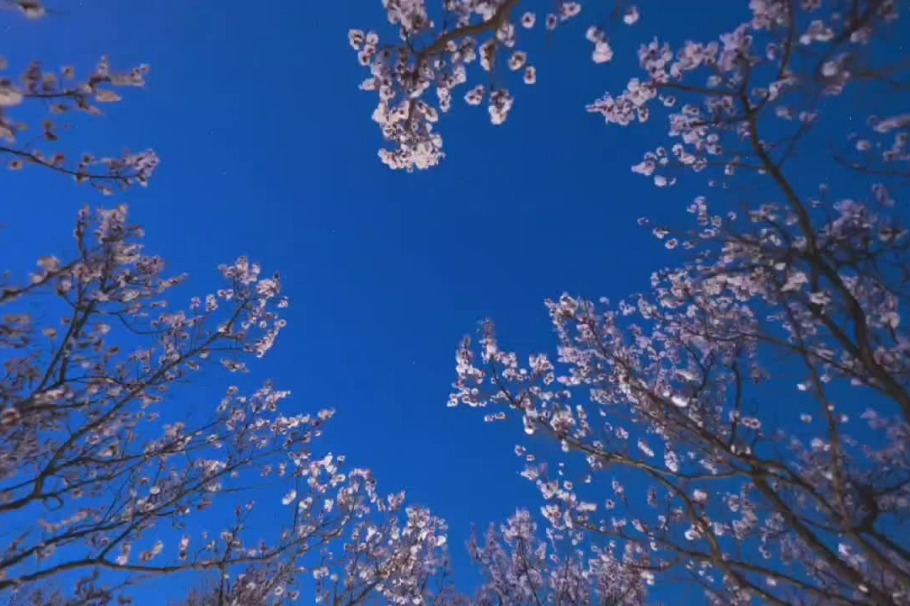Travel around
Activities reflect vibrant local traditions
Updated:2022-02-18 10:41By Yuan Shenggao ( China Daily)

Datiehua, or the molten iron fireworks show, is an art form that was listed as an intangible cultural heritage in Shanxi in 2011. The art is a popular way to celebrate Spring Festival in the city of Jincheng. [Photo by Xing Lanfu for China Daily]
The traditional occasion for family reunion, the Spring Festival period, which lasts more than a month centering on the first day of the first lunar month, is the most enjoyable time for residents in Shanxi, thanks to the rich variety of folk activities throughout the province.
Flowery buns
The city of Yuncheng in the south of Shanxi is known as the granary of Shanxi, as it produces more than half of the province's wheat output. So its Spring Festival celebration is closely related to wheat.
Making snacks with wheat, especially dough buns, is among the most popular ways to celebrate Spring Festival for many families in the city.
According to the locals, the dough snacks are meant not only to serve diners during the most important festival of the year, but also to bring fortune and good luck to families.
Wenxi, a county in the south of Shanxi, is renowned throughout the province for its auspicious dough buns, which are also known as "flowery buns" among locals.
Flowery buns there are made with centuries-old techniques, and the process was included on China's intangible cultural heritage list in 2008. And the county is called "the hometown of flowery buns".
Making flowery buns is a complicated process and requires a lot of effort, so preparations always begin half a month before Lunar New Year.
The flowery buns usually feature the shapes of auspicious animals. As this year is the Year of the Tiger, tiger buns are especially popular among residents of Wenxi. The variety is especially favored by parents as the tiger is a lucky animal for children, symbolizing strength, courage and health.
People there also send flowery buns as gifts when they visit relatives or friends, which is regarded as a show of best wishes.
Molten iron fireworks
The city of Jincheng is known for its show of Datiehua, or molten iron fireworks, during the Spring Festival and Lantern Festival period.
Molten iron fireworks are related to the iron-smelting industry as it used to be performed by iron-smelting workers or blacksmiths. The tradition has been in Jincheng for centuries along with the region's development of coal-mining and metallurgy industries.
The traditional performance, involving the spray of molten iron, is an art form that was listed as an intangible cultural heritage in Shanxi in 2011.
Using a wooden ladle soaked in water for three days, folk artists perform this stunt by throwing arcs of burning molten metal-be it iron, copper or aluminum-at a temperature of about 1,600 C, through the air, which bursts into glowing sparks onto a cold and hard wall, delighting audiences.
By using various kinds of metals, the performers can create a multicolored array of "flowers". Wearing special protective clothes and helmets, the bravest performer would throw the molten iron over his head, creating an umbrella-shaped shower of sparks.
Legend has it that in ancient times, blacksmiths used to throw hot melted iron against the cold walls during Lantern Festival. When the metal struck the walls, it exploded into a shower of sparks to scare demons away. The centuries-old tradition has now become a popular performance to celebrate festivals or entertain tourists.
Drum performance
In the southern Shanxi city of Linfen, the Weifeng Luogu show, which literally means the grand performance of drums, is the most popular among many Spring Festival celebration arts.
Linfen is said to be the birthplace of the performing art, which is believed to have a history of more than 1,000 years.
Researchers also said Linfen is the cradle of drums. Early in 1980, local archaeologists excavated ancient drums in Taosi village in the city, a relic that belongs to the Longshan Culture along the middle reach of the Yellow River about 4,000 to 4,600 years ago. These drums were proved to be 4,300 to 4,500 years old.
Listed on the national intangible heritage list in 2006, the Weifeng Luogu show features 30 to over 100 traditionally clothed performers, who dance while beating their drums of different sizes.
Historical records indicate that the origin of Weifeng Luogu dates back to the period of Li Shimin, the second emperor of the Tang Dynasty (618-907). Having put down a rebellion in Shanxi, his army celebrated his victory by playing a grand drum show. Since then, Weifeng Luogu has spread far and wide and it is widely used in weddings and celebration ceremonies, gatherings and traditional festivities to welcome gods and exorcise evil spirits.
The technique of artistic expression of this form of art has been greatly enriched through hundreds of years of constant development, with a variety of percussive instruments like cymbals and gongs added to the performance.
Paper-cutting arts
Putting paper-cuts on the windows is a tradition in the city of Changzhi, as well as the rest of Shanxi for Lunar New Year celebration.
In Changzhi, paper-cutting demonstrates the principles of Chinese aesthetics, showing conceptions of the universe and life. The art portrays the essence of Chinese society in the colorful folk craft. The images that paper-cutting artists create include the figures of people, flowers and auspicious animals or even simple opera and folk customs and facial makeups.
Paper-cutting is so popular in Changzhi that it is said every household there has at least one member good at the art. They usually bring a pair of scissors with them, ready to make some paper-cuts at any time when they are free.
Temple fire show
The county of Pingyao, a renowned tourist destination in Shanxi, has made it a tradition to celebrate Spring Festival and Lantern Festival with Shehuo shows.
Shehuo, which can translate into temple fire, originally involved parades with lit lanterns and torches. With its origin dating back to the prehistorical period, it was among the oldest rituals and ceremonies in China to offer sacrifices to the god of earth.
Over the millennia that followed, the ritual has evolved into a traditional Chinese-styled carnival that involves various folk shows and performances.
In Pingyao, the township of Gutao was recognized as "the hometown of Shehuo" by the Chinese Folk Literature and Art Association in 2007, for its long history in this tradition and its rich variety of shows.
The Shehuo celebrations in Gutao, as well as the rest of Pingyao, include lantern shows, stilt walking, acrobatics, local opera performances, and dragon and lion dances as well drum dances. In recent years, new forms of shows, including float parades and military band performances, have been added to this occasion.
In the city of Datong in northern Shanxi, the Shehuo performances also include blowing big trumpets, boating on land and story telling and ballad singing.
Lantern show
In the old county seat of Taiyuan, a tourist destination in the Shanxi provincial capital of Taiyuan, which was reopened to visitors last year after eight years of renovation to repair and restore its old residences, streets and city walls, visitors during this year's Spring Festival period can witness a lantern show spanning about one month.
The show started on Spring Festival that fell on Feb 2 and will last to the Day of Longtaitou. Longtaitou, which means the rise of dragon's head and is celebrated on the second day of the second lunar month, marks the beginning of farming activities.
On this day, people usually decorate temples of the earth god with lit lanterns and provide it with sacrifices. And lanterns of different sizes, shapes and color, have become an important part of a show to entertain locals and tourists.
The show in the old county seat of Taiyuan consists of 150 groups of big lanterns, with the largest one being 30 meters in length and 12 meters in height.
Sugar paintings
In the city of Xinzhou, locals and tourists can have a nostalgic taste during this Spring Festival holiday when walking on the streets where sugar painting vendors can be spotted here and there.
The making of sugar paintings is more of an art rather than a cooking skill. Sugar painting always plays an indispensable part in people's childhood as a piece of such sweet art could be bought with affordable prices in the old days and is still the same at present.
A vendor, as people can see in Xinzhou, with master's skills and techniques, can make almost everything out of molten sugar, be it a fish, a dragon, a monkey, or plants and flowers.
The painter uses brown or white sugar as the raw material, a bronze spoon and a shovel as the tool, and the slab of marble as the "paper". After heating for some while, the liquid sugar falls down as a thin thread onto the "paper" from the slanting spoon, and various figures are created. Most kids would be excited to see the sweet art shining golden under the sun.
Wang Pei and Li Shu contributed to this story.



